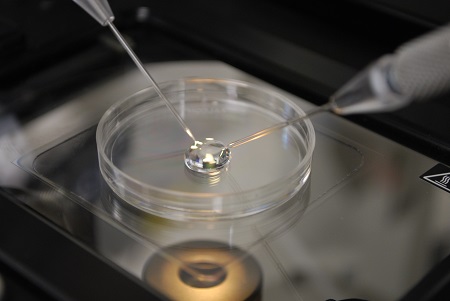
For the Ben-Zion* family, retinitis pigmentosa is a fact of life. A genetic disorder that causes loss of peripheral vision and poor night vision, retinitis pigmentosa often leads to blindness. Numerous Ben-Zions inherited the disorder, but family member Ilana,* 39, wanted to make absolutely sure her children would have full eyesight.
By chance, she heard about Hadassah Medical Organization’s preimplantation genetic diagnosis (PGD) program in which scientists test embryos created through in vitro fertilization (IVF) for genetic diseases. The Department of Genetics and the IVF laboratory test for a variety of diseases, but for Jerusalemite Ilana, eye disease was the main concern.
“There was a 50-50 chance that my baby could have this and could have been worse off than I am,” says Ilana. “If a child is born blind, that’s a big deal.”
Hereditary forms of eye disease-account for as many as half of all childhood blindness cases in developed countries areas such as Europe and the United States.
While there is currently no cure for retinitis pigmentosa, there are constantly improving methods for identifying and detecting such disease-causing mutations. Through genetic counseling, testing, and prenatal and/or preimplantation diagnostics, doctors can help prevent mothers from giving birth to children with a variety of conditions, including hereditary blindness.
After fertility treatment, says Dr. Tal Imbar, who heads Hadassah’s Fertility Preservation Service, “we remove as many eggs as we can, and one at a time we fertilize them with the father’s sperm in our laboratory. We then place the embryos in an incubator for three days. When they have approximately eight cells we remove one or usually two cells for testing.” Only the embryos that are free of the genetic mutation are implanted.
Dr. Imbar’s staff works closely with other teams across Hadassah, including the Department of Ophthalmology. Senior ophthalmologist Dr. Claudia Yahalom, of the Michaelson Institute for the Rehabilitation of Vision at Hadassah, believes it’s vital that ophthalmologists inform patients of the PGD option.
“This could avoid having a child with a potentially devastating genetic form of eye disease or ocular cancer,” writes Dr. Yahalom and her colleagues in a paper entitled Preimplantation Genetic Diagnosis as a Strategy to Prevent Having a Child Born with a Heritable Eye Disease. “This strategy is highly relevant, particularly given the limited options currently available for treating these conditions.”
That paper is based on research by Dr. Yahalom and her colleagues, including Dr. Imbar, genetic counselor Michal Macarova, and senior physician Dr. Jordana H. Hyman. They looked at the PGD results for 35 women. Of those, 18 gave birth and all to healthy children.
“We might not be able to remove some of these diseases from the world because there are always new mutations, but, with families who know they are at risk, we can prevent them from passing it on to their children,” says Dr. Imbar.
Ilana has two healthy children, both born after PGD, and is considering having a third child. “I feel it was the right decision. I’m so lucky I live in a time where there is prevention. I would never go anywhere other than Hadassah.”
*Not the real name
Photo caption: Removing embryonic cells for genetic testing
